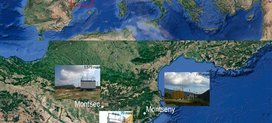
ATMO-ACCESS TNA grantees Barcelona 2022
On November 7-11, the Universitat Politècnica de Catalunya (UPC) granted access to Barcelona Cluster (CSIC-UPC) resources to the University of Warsaw and the Finnish Meteorological Institute, as part of the ATMO-ACCESS Trans-National Access (TNA) program. The mission of ATMO-ACCESS is to provide coordinated, open access to the most advanced atmospheric research facilities in Europe.
Barcelona Cluster (CSIC-UPC) is a unique atmospheric research infrastructure located in northern Spain. It includes three observation platforms: Montsec (MSA, in the mountains, 1590 m.a.s.l.), Montseny (MSY, in the region, 720 m.a.s.l.), and Barcelona (BCN, in the city, 78 m.a.s.l.). The network of sites is well equipped with instrumentation that meets ACTRIS requirements for in-situ aerosol observation (MSA, MSY, and BCN) as well as remote sensing (BCN) facilities. All facilities are also equipped with trace gas instruments, and two of them (MSY and BCN) will be equipped with instruments for online measurement of volatile organic compounds. MSA and MSY also have ceilometers in operation, and BCN has an MPLNET lidar.
Access to the Barcelona Cluster infrastructure (CSIC-UPC) allows for the study of climate, air quality, and its impact on health, in the three aforementioned ecosystems. It is the only infrastructure as such in the Western Mediterranean Basin, a unique region for atmospheric research given the high insolation, the specific meteorology, the elevated emissions of pollutants, and the frequent impact of dust outbreaks.
Participants in the program were:
- Group Leader I: mgr Artur Tomczak
- Group I participant: dr hab. Iwona Stachlewska, prof. ucz.
- Group leader II: dr Xiaoxia Shang
- Supervisors at the UPC facility: Prof. Michaël Sicard, Prof. Alejandro Rodriguez Gomez, Prof. Adolfo Comeron Tejero, mgr Daniel Camilo, mgr Cristina Gil Diaz
The topic of the training was to expand competency in aerosol typing for airborne pollen particles over the urban mainland in the near-wall layer using remote (lidar) and in-situ methods.
During the project, a new method was used to detect pure pollen by determining its depolarization coefficient. For this purpose, a new method using the relationship between the Ångström exponent associated with backscattering and the coefficient of linear depolarization of the particles was used (Shang et al. 2022). The UPC team demonstrated the operation of the state-of-the-art lidar and provided detailed information on the techniques used and the scopes of operation.
The collaboration resulted in new ideas for the development of a method for pure pollen detection presented by Shang (et al. 2022) and a desire to continue further research between the units. The results of the collaboration will be directly used within the framework of mgr Artur Tomczak's PhD thesis and for the PRELUDIUM BIS project.
Shang, X., Baars, H., Stachlewska, I. S., Mattis, I., & Komppula, M. (2022). Pollen observations at four EARLINET stations during the ACTRIS-COVID-19 campaign. Atmospheric Chemistry and Physics, 22(6), 3931-3944.
Originally published on - Nov. 15, 2022, 3 p.m.
Last update on - Nov. 15, 2022, 4:10 p.m.
Publisher - Sekretariat IGF

